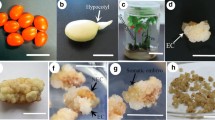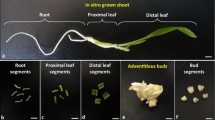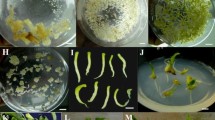Abstract
Using cotyledons as explants a new method of peanut regeneration was established via somatic embryogenesis (SE), involving a kind of first-observed SE structure that was shaped like bulbil and therefore named bulbil-like body (BLB). On Murashige and Skoog (MS) media containing a higher concentration of 2,4-D (20.0 mg/L) and incubated in the dark, all the inoculated cotyledon explants formed BLBs with a high frequency of average 26 BLBs per cotyledon explant, and 100.00 % of the formed BLBs spontaneously developed into multiple shoots (3–5 shoots per BLB) without changing induction and incubation conditions. On average, about 103 shoots can be induced from an individual cotyledon explant. On MS media supplemented with 1.0 mg/L NAA all the separated shoots formed normal roots to develop into plantlets. The morphological and histological analyses of BLBs at different development stages revealed that BLB was a special kind of SE structure originated from cortex cells of peanut cotyledon explants, and each individual BLB was composed of multiple embryoids further developing into multiple shoots. To our knowledge, BLB is a novel type of SE structure in peanut different from the known SE structures because of its special shape, induction conditions, somatic embryogenic nature, and multiple-embryoid characteristics.



Similar content being viewed by others
Abbreviations
- 2,4-D:
-
2,4-Dichlorophenoxyacetic acid
- ANOVA:
-
Analyses of variance
- BLB:
-
Bulbil-like body
- FCDZ:
-
Fast-cell-division zone
- FELB:
-
Frog egg-like body
- MS:
-
Murashige and Skoog
- NAA:
-
1-Naphthaleneacetic acid
- PGR:
-
Plant growth regulator
- PLB:
-
Protocorm-like body
- RTB:
-
Rhizoid tuber
- SE:
-
Somatic embryogenesis
- TDZ:
-
Thidiazuron
References
Anuradha TS, Jami SK, Datla RS, Kirti PB (2006) Genetic transformation of peanut (Arachis hypogaea L.) using cotyledonary node as explant and a promoterless gus:nptII fusion gene based vector. J Biosci 31(2):235–246
Baker CM, Wetzstein HY (1992) Somatic embryogenesis and plant regeneration from leaflets of peanut. Arachis hypogaea. Plant Cell Rep 11(2):71–75
Cheng M, Jarret RL, Li Z, Xiang A, Demski JW (1996) Production of fertile transgenic peanut (Arachis hypogaea L.) plants using Agrobacterium tumefaciens. Plant Cell Rep 15:653–658
de Almeida M, de Almeida CV, Mendes Graner E, Ebling Brondani G, Fiori de Abreu-Tarazi M (2012) Pre-procambial cells are niches for pluripotent and totipotent stem-like cells for organogenesis and somatic embryogenesis in the peach palm: a histological study. Plant Cell Rep 31(8):1495–1515
Deng XY, Wei ZM, An HL (2001) Transgenic peanut plants obtained by particle bombardment via somatic embryogenesis regeneration system. Cell Res 11(2):156–160
Durham RE, Parrott WA (1992) Repetitive somatic embryogenesis from peanut cultures in liquid medium. Plant Cell Rep 11(3):122–125
Filonova LH, Bozhakov PV, von Arnold S (2000) Developmental pathway of somatic embryogenesis in Picea abies as revealed by time-lapse tracking. J Exp Bot 51:249–264
Kanyand M, Dessai AP, Prakash CS (1994) Thidiazuron promotes high frequency regeneration of peanut (Arachis hypogaea) plants in vitro. Plant Cell Rep 14(1):1–5
Kerbauy GB (1984) Plant regeneration of Oncidium varicosum (Orchidaceae) by means of root tip culture. Plant Cell Rep 3(1):27–29
Krishna G, Singh BK, Kim EK, Morya VK, Ramteke PW (2015) Progress in genetic engineering of peanut (Arachis hypogaea L.)–a review. Plant Biotechnol J 13(2):147–162
Kumar V, Moyo M, Van Staden J (2015) Somatic embryogenesis of Pelargonium sidoides DC. Plant Cell, Tissue Organ Cult 121(3):571–577
Liu F, Abdurazaka I, Xi L, Gao B, Wang L, Tian C, Zhao L (2014) Morphohistological analysis of the origin and development of Rosa canina protocorm-like bodies. Sci Hortic 167:107–116
Matand K, Prakash CS (2007) Evaluation of peanut genotypes for in vitro plant regeneration using thidiazuron. J Biotechnol 130(2):202–207
Mikuła A, Pożoga M, Tomiczak K, Rybczyński JJ (2015) Somatic embryogenesis in ferns: a new experimental system. Plant Cell Rep 34(5):783–794
Ozias-Akins P (1989) Plant regeneration from immature embryos of peanut. Plant Cell Rep 8(4):217–218
Rathore MS, Paliwal N, Anand KGV, Agarwal PK (2015) Somatic embryogenesis and in vitro plantlet regeneration in Salicornia brachiata Roxb. Plant Cell, Tissue Organ Cult 120(1):355–360
Reinert J (1958) Morphogenesis und ihre kontrolle an gewebekulturn aaus karotten. Naturwissenschaften 45:344–345
Reinert J (1959) Uber die kontrolle der morphogenese und die indukttion von advienticeembryonen an gewebekulturen aus karotten. Planta 58:318–333
Satish L, Rency AS, Rathinapriya P, Ceasar SA, Pandian S, Rameshkumar R, Rao TB, Balachandran SM, Ramesh M (2016) Influence of plant growth regulators and spermidine on somatic embryogenesis and plant regeneration in four Indian genotypes of finger millet (Eleusine coracana (L.) Gaertn). Plant Cell, Tissue Organ Cult 124(1):15–31
Smertenko A, Bozhkov PV (2014) Somatic embryogenesis: life and death processes during apical-basal patterning. J Exp Bot 65(5):1343–1360
Steiner N, Farias-Soares FL, Schmidt ÉC, Pereira ML, Scheid B, Rogge-Renner GD, Bouzon ZL, Schmidt D, Maldonado S, Guerra MP (2015) Toward establishing a morphological and ultrastructural characterization of proembryogenic masses and early somatic embryos of Araucaria angustifolia (Bert.) O. Kuntze. Protoplasma. doi:10.1007/s00709-015-0827-0
Steward FC (1958) Growth and development of cultivated cells. III. Interpretations of growth from free cell to carrot plant. Am J Bot 45:709–713
Tian C, Chen Y, Zhao X, Zhao L (2008) Plant regeneration through protocorm-like bodies induced from rhizoids using leaf explants of Rosa spp. Plant Cell Rep 27(5):823–831
Tiwari V, Chaturvedi AK, Mishra A, Jha B (2015) An efficient method of agrobacterium-mediated genetic transformation and regeneration in local Indian cultivar of groundnut (Arachis hypogaea) using grafting. Appl Biochem Biotechnol 175(1):436–453
Xu C, Zhao L, Pan X, Šamaj J (2011) Developmental localization and methylesterification of pectin epitopes during somatic embryogenesis of banana (Musa spp AAA). PLoS ONE 6(8):e22992
Xu K, Chang Y, Liu K, Wang F, Liu Z, Zhang T, Li T, Zhang Y, Zhang F, Zhang J, Wang Y, Niu W, Jia S, Xie H, Tan G, Li C (2014) Regeneration of Solanum nigrum by somatic embryogenesis, involving frog egg-like body, a novel structure. PLoS ONE 9(6):e98672
Xu K, Chang Y, Zhang J, Wang P, Wu J, Li Y, Wang X, Wang W, Liu K, Zhang Y, Yu D, Liao L, Li Y, Ma S, Tan G, Li C (2015) A Lower pH value benefits regeneration of Trichosanthes kirilowii by somatic embryogenesis, involving rhizoid tubers (RTBs), a novel structure. Sci Rep 5:8823–8833
Acknowledgments
The research was funded by National Natural Science Foundation of China (No. 31272168) (http://www.nsfc.gov.cn/), Science and Technology Research Major Projects of Department of Education of Henan Province (Nos. 13B210270 and 14A180003) (http://www.haedu.gov.cn/), Department of Science and Technology Planning Project of Henan Province (No. 144300510064) (http://www.hnkjt.gov.cn/), Doctoral Scientific Research Starting Foundation of Zhoukou Normal University (No. zksybscx201108) (http://www.zknu.edu.cn/), Scientific Research and Innovation Fund Projects of Zhoukou Normal University (No. zksykycx201306) (http://www.zknu.edu.cn/).
Author information
Authors and Affiliations
Corresponding authors
Ethics declarations
Conflict of interest
The authors declare that the research was conducted in the absence of any commercial or financial relationships that could be construed as a potential conflict of interest.
Additional information
Kedong Xu and Bingyan Huang have contributed equally to this study.
Rights and permissions
About this article
Cite this article
Xu, K., Huang, B., Liu, K. et al. Peanut regeneration by somatic embryogenesis (SE), involving bulbil-like body (BLB), a new type of SE structure. Plant Cell Tiss Organ Cult 125, 321–328 (2016). https://doi.org/10.1007/s11240-016-0952-2
Received:
Accepted:
Published:
Issue Date:
DOI: https://doi.org/10.1007/s11240-016-0952-2




